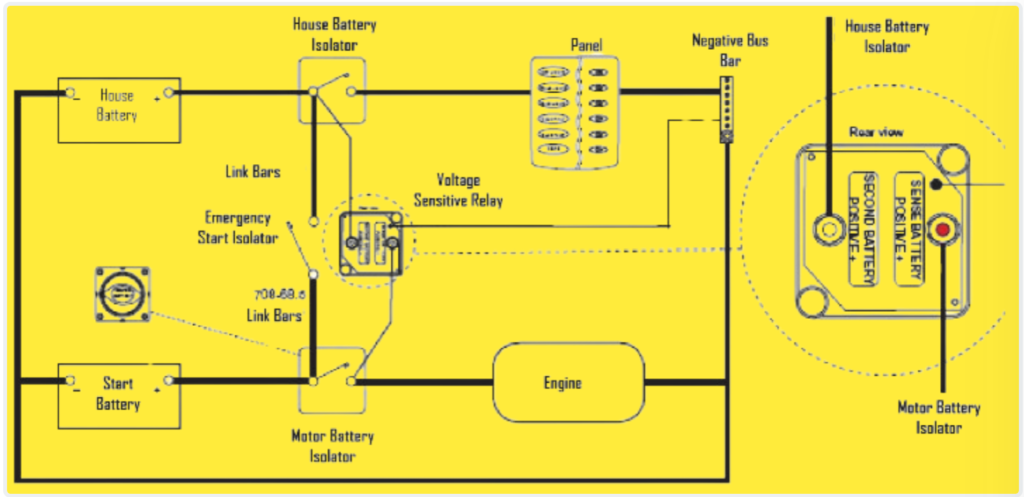In the world of electrical engineering, ensuring the stability and reliability of power distribution systems is very important. One integral component that helps in this endeavor is the voltage sensitive relay (VSR). In this article, we explain into the workings of VSRs, their applications, and their significance in modern electrical engineering practices.
What is a Voltage Sensitive Relay (VSR)?
A voltage sensitive relay is an electromechanical device designed to detect voltage variations within an electrical circuit and initiate specific actions based on predetermined voltage thresholds. It acts as a protective measure, responding to voltage deviations to protect equipment, prevent damage, and maintain system stability.
How Does a Voltage Sensitive Relay Work?
In our example of below diagram, i tried to explain operation and working principle of VSR. Assume following specification for VSR.
Specifications:
- Continuous Current: 120 Amps
- Intermittent Current: 140 Amps
- Voltage System: 12V DC
- Sense: Dual
- Cut-in/Cut-out Voltage: 13.7V DC / 12.8V DC.
How the VSR Works?
When the voltage of the starting battery rises above 13.7V DC, the VSR activates and switches to charge both batteries in parallel. This ensures that both batteries receive the necessary charge to maintain optimal performance.
Upon detecting a voltage drop below 12.8V DC, the VSR disengages to prevent over-discharge of the batteries. This feature safeguards against excessive drain and extends the lifespan of the batteries.
During the switching process, a buzzer-like sound is produced, indicating the activation and deactivation of the relay. This audible feedback provides reassurance of the VSR’s operation status.

The VSR’s operation is responsive to changes in engine RPM. An increase in engine speed enhances alternator output, stabilizing voltage levels and ensuring efficient charging, even at low speeds or idle conditions.
A VSR comprises sensing elements, control circuits, and switching mechanisms. When connected to an electrical circuit, the VSR continuously monitors the voltage levels. Upon detecting voltage variations that exceed predefined thresholds, the relay triggers its switching mechanism to initiate predetermined actions, such as opening or closing electrical contacts.
Applications of Voltage-Sensitive Relays:
- Overvoltage Protection: VSRs are commonly used to protect electrical equipment from damage caused by excessive voltage levels. In case of voltage spikes or surges beyond acceptable limits, the relay disconnects the affected equipment from the power source, preventing potential damage.
- Undervoltage Protection: Conversely, VSRs can also protect equipment from undervoltage conditions, where voltage levels drop below specified thresholds. By detecting such occurrences, the relay can trigger actions to prevent the effects of undervoltage, such as activating backup power sources or initiating shutdown procedures.
- Voltage Monitoring and Control: Voltage sensitive relays play a vital role in monitoring voltage levels in electrical systems, ensuring that they remain within safe operating ranges. They can be integrated into control systems to provide real-time voltage monitoring and facilitate automatic adjustments to maintain system stability.
- Automatic Transfer Switching: In applications requiring seamless transfer between primary and backup power sources, VSRs are used to detect voltage discrepancies and initiate transfer operations. This ensures uninterrupted power supply to critical loads during power outages or fluctuations.
Significance in Electrical Engineering:
Voltage sensitive relays are indispensable in modern electrical engineering practices due to their versatility, reliability, and effectiveness in protecting electrical systems and equipment. By quick responding to voltage fluctuations, VSRs help prevent equipment damage, minimize downtime, and enhance the overall reliability of electrical systems.
In summary, voltage sensitive relays are essential components in electrical systems, serving as protective equipment against voltage fluctuations and ensuring the stability and reliability of power distribution networks. Their ability to detect voltage variations and initiate appropriate actions underscores their significance in safeguarding equipment, preventing damage, and maintaining system integrity in various applications across diverse industries.
As electrical engineers continue to innovate and advance technology, the role of voltage sensitive relays remains pivotal in ensuring the efficiency and resilience of electrical systems in the face of dynamic operating conditions and evolving challenges.